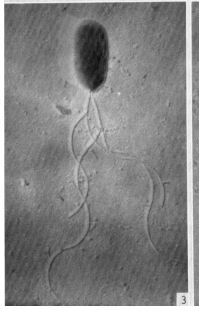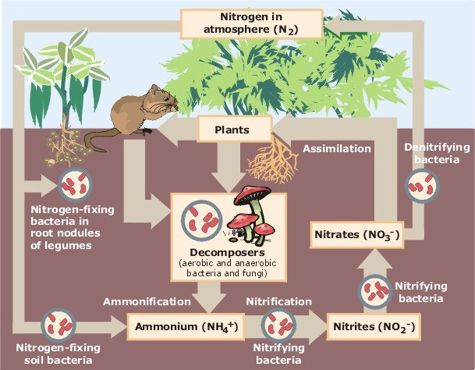Azotobacter chroococcum: Difference between revisions
| Line 47: | Line 47: | ||
''Azotobacter chroococcum'' is a free-living bacterium in the soil | ''Azotobacter chroococcum'' is a free-living bacterium in the soil | ||
[[Image:Nitrogen_Cycle.jpg|thumb|600px|center| Nitrogen Fixation. Image credit: Bailey Smith, EPA]] | |||
==References== | ==References== | ||
Revision as of 12:26, 13 December 2022
Classification
Bacteria; Proteobacteria; Gammaproteobacteria; Pseudomonadales; Pseudomonadaceae
Species
|
NCBI: [1] |
Azotobacter chroococcum
Description and Significance
Azotobacter chroococcum colonies are characterized by a creamy color, circular shape, and smooth convex type. Single bacterium are characterized by a rod shape and are motile by way of a flagella (Talabani et al. 2019). This bacteria inhabits neutral and slightly alkaline soils, with an optimal pH range of 7.1-9.0. The strongest influence of Azotobacter chroococcum abundance in soil is the total nitrogen and organic carbon contents. The strong correlation of Azotobacter chroococcum abundance with total nitrogen content is most likely due to their nitrogen fixation ability (Lenart 2011). These bacteria are important not only to the nitrogen cycle, but also to agricultural sustainability and soil remediation.
Genome Structure
Only one strain of the bacterial species Azotobacter chroococcum has been sequenced in its entirety. The genome of Azotobacter chroococcum NCIMB 8003 (ATCC 4412)(Ac-8003) consists of a singular, circular chromosome and six plasmids pAcX50a, b, c, d, e, f totaling 5,192,291 bp. The chromosome contains 4,591,803 bp while the six plasmids contain 10,435 bp, 13,852 bp, 62,783 bp, 69,713 bp, 132,724 bp, and 311,724 bp respectively. The chromosome has a G+C content of 66.27% while the six plasmids have a G+C content of 58.1%, 55.3%, 56.7%, 59.2%, 61.9%, and 62.6% respectively. The genome also encodes 4628 predicted protein-encoding genes and 258 transposase (Robson et al. 2015).
Cell Structure, Metabolism and Life Cycle
how it gains energy; what important molecules it produces.
Azotobacter chroococcum is a free-living, obligately-aerobic, gram negative bacterium that has the ability for atmospheric nitrogen fixation (Robson et al. 2015, Talabani et al. 2019). These bacteria are motile by way of a singular flagella, and move towards root exudates by chemotaxis (Kumar et al. 2007). Azotobacter chroococcum is a heterotroph, and obtains carbon through fructose, galactose, glucose, trehalose, starch, glycogen, ethanol, butan-1-ol, pentan-1-ol, mannitol, sorbitol, myo-inositol, and caproate (Robson et al. 2015).
Ecology and Pathogenesis
Habitat; symbiosis; biogeochemical significance; contributions to environment.
Azotobacter chroococcum is a free-living bacterium in the soil
References
Robson RL, Jones R, Robson RM, Schwartz A, Richardson TH. 2015. Azotobacter Genomes: The Genome of Azotobacter chroococcum NCIMB 8003 (ATCC 4412). PLOS ONE. [accessed 2022 November 20;10(6):e0127997. doi:10.1371/journal.pone.0127997.]
Talabani SK, Fattah OA, Khider AK. 2019. CLASSICAL AND MOLECULAR APPROACHES FOR IDENTIFICATION OF RHIZOBIUM LEGUMINOSARIUM, AZOTOBACTER CHROOCOCCUM AND BACILLUS MEGATERIUM. APPLIED ECOLOGY AND ENVIRONMENTAL RESEARCH. [accessed 2022 November 21;17(5):12491-12506. doi:10.15666/aeer/1705_1249112506.]
Kumar R, Bhatia R, Kukreja K, Behl RK, Dudeja SS, Narula N. 2007. Establishment of Azotobacter on plant roots: chemotactic response, development and analysis of root exudates of cotton (Gossypium hirsutum L.) and wheat (Triticum aestivum L.). Journal of Basic Microbiology. [accessed 2022 November 21;47(5):436-439. doi:10.1002/jobm.200610285.]
Bisset KA, Hale CMF. 1953. The Cytology and Life-cycle of Azotobacter chroococcum. Journal of General Microbiology. [accessed 2022 December 12;8(3):442-448. doi:10.1099/00221287-8-3-442.]
Author
Page authored by Isabella Ickes, student of Prof. Bradley Tolar at UNC Wilmington.


